GMC SIERRA 1996 Owners Manual
Manufacturer: GMC, Model Year: 1996, Model line: SIERRA, Model: GMC SIERRA 1996Pages: 404, PDF Size: 21.57 MB
Page 191 of 404
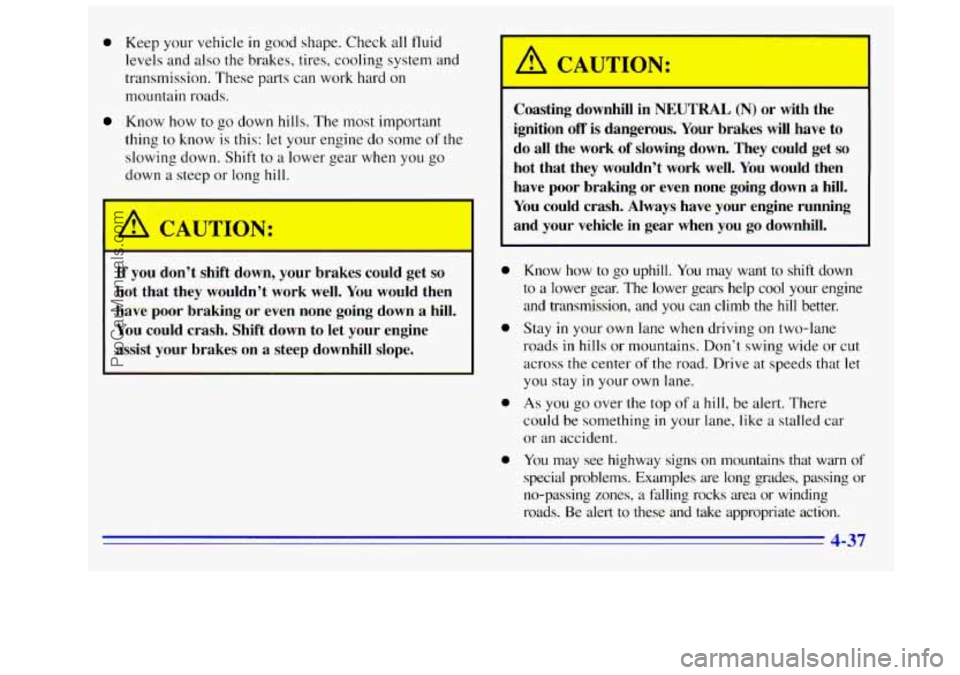
0 Keep your vehicle in good shape. Check all fluid
levels and also the brakes, tires. cooling system and
transmission. These parts can work hard on
mountain roads.
Know how to go down hills. The most important
thing to know is this: let your engine
do some of the
slowing down. Shift
to a lower gear when you go
down a steep or long hill.
If you don’t shift down, your brakes could get
so
hot that they wouldn’t work well. You would then
have poor braking or even none going down a hill.
You could crash. Shift down to let your engine
assist your brakes on
a steep downhill slope.
0
0
0
0
~h CAUTION:
Coasting downhill in NEUTRAL (N) or with the
ignition
off is dangerous. Your brakes will have to
do
all the work of slowing down. They could get so
hot that they wouldn’t work well. You would then
have poor braking
or even none going down a hill.
You could crash. Always have your engine running
and your vehicle in gear when you go downhill.
Know
how to go uphill. You may want to shift down
to a lower gear. The lower gears help cool your engine
and transmission, and
you can climb the hill better.
Stay
in your own lane when driving on two-lane
roads
in hills or mountains. Don’t swing wide or cut
across the center
of the road. Drive at speeds that let
you stay
in your own lane.
As you go over the top of a hill, be alert. There
could be something
in your lane, like a stalled car
or an accident.
You may see highway signs on mountains that warn of
special problems. Examples are long grades, passing or
no-passing zones, a falling rocks area’or winding
roads. Be alert to these and take appropriate action.
4-37
ProCarManuals.com
Page 192 of 404
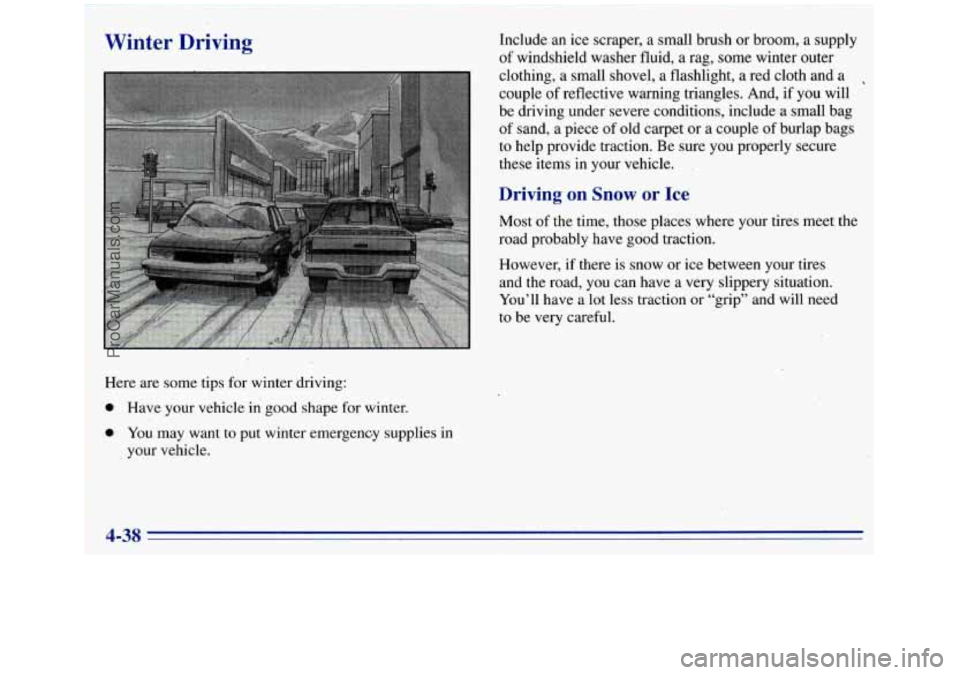
Winter Driving
Here are some tips for winter driving:
0 Have your vehicle in good shape for winter.
0 You may want to put winter emergency supplies in
your vehicle. 1nclude.an ice
scraper, a small brush
or broom, a supply
of windshield washer fluid, a rag, some winter outer
clothing, a small shovel, a flashlight, a red cloth and a
,
couple of reflective warning triangles. And, if you will
be driving under severe conditions, include
a small bag
of sand, a piece of old carpet or a couple of burlap bags
to help provide traction. Be sure you properly secure
these items in your vehicle.
Driving on Snow or Ice
Most of the time, those places where your tires meet the
road probably have good traction.
However,
if there is snow or ice between your tires
and the road,
you can have a very slippery situation.
You’ll have a lot less traction or “grip” and will need
to be very careful.
4-3s
ProCarManuals.com
Page 193 of 404
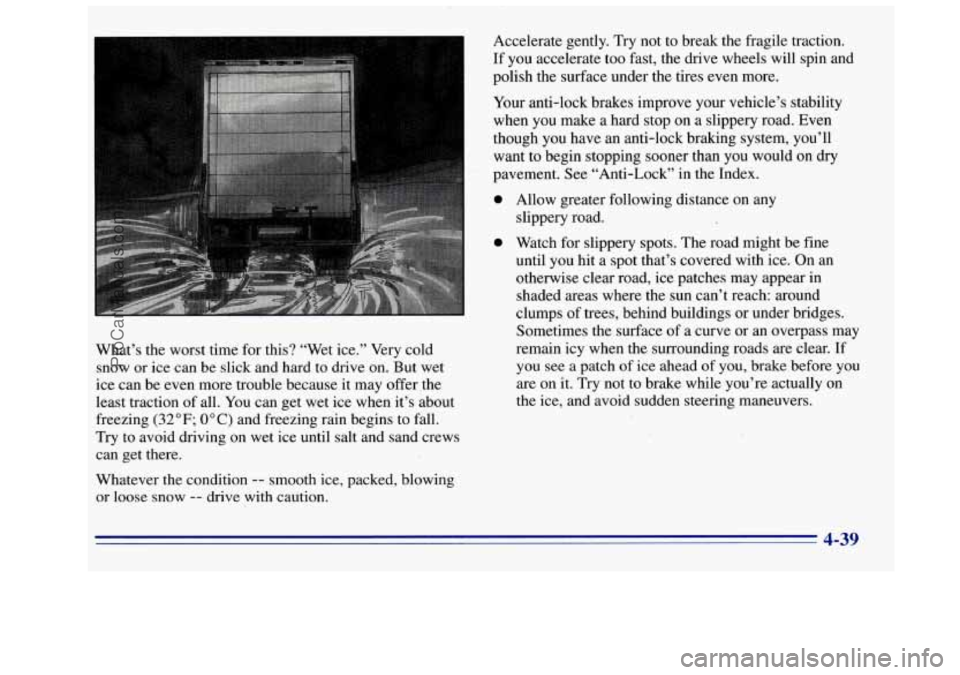
What’s the worst time for this? “Wet ice.” Very cold
snow or ice can be slick and hard to drive on. But wet
ice can be even more trouble because it may offer,the
least traction of all. You can get wet ice when it’s about
freezing
(32 OF; 0 O C) and freezing rain begins to fall.
Try to avoid driving on wet ice until salt and sand crews
can get there.
Whatever the condition
-- smooth ice, packed, blowing
or loose snow
-- drive with caution. Accelerate
gently. Try not to break the fragile traction.
If you accelerate too fast, the drive wheels will spin and
polish the surface under the tires even more.
Your anti-lock brakes improve your vehicle’s stability
when you make a hard stop on a slippery road. Even
though you have an anti-lock braking system, you’ll
want to begin stopping sooner than you would on dry
pavement. See “Anti-Lock”
in the Index.
0 Allow greater following distance on any
slippery road.
0 Watch for slippery spots. The road might be fine
until you hit a spot that’s covered with ice. On an
otherwise clear road, ice patches may appear in
shaded areas where the sun can’t reach: around
clumps
of trees, behind buildings or under bridges.
Sometimes the surface
of a curve or an overpass may
remain icy when the surrounding roads are clear. If
you see a patch of ice ahead of you, brake before you
are on it. Try not to brake while you’re actually on
the ice, and avoid sudden steering maneuvers.
4-39
ProCarManuals.com
Page 194 of 404
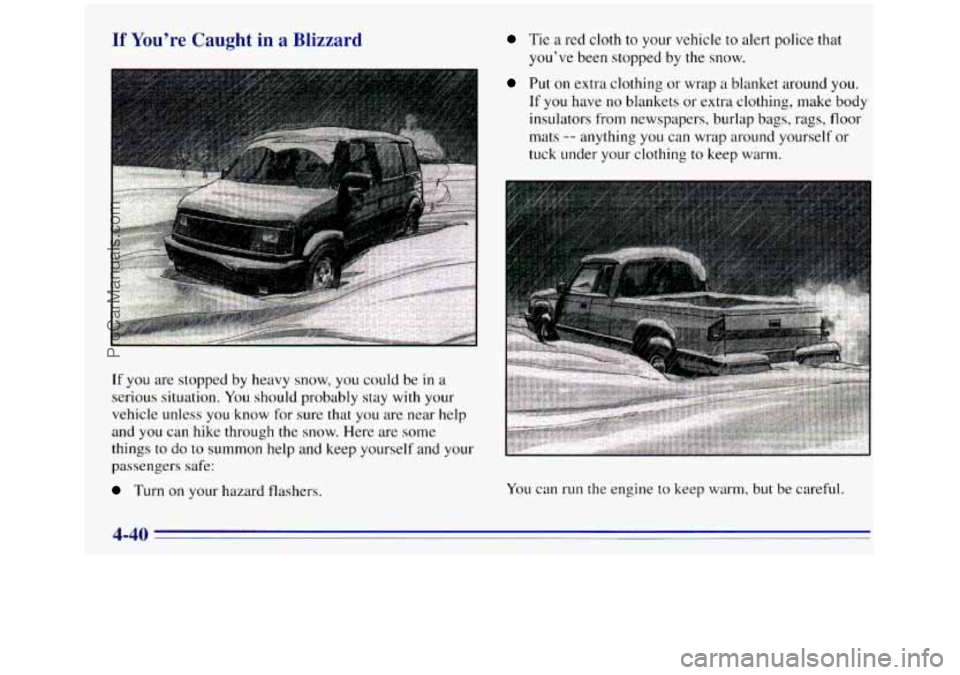
If You’re Caught in a Blizzard
-
Tie a red cloth to your vehicle to alert police that
you’ve been stopped
by the snow.
If
you are stopped by heavy snow, you could be in a
serious situation.
You should probably stay with your
vehicle unless you know for sure that you are near help
and
you can hike through the snow. Here are some
things to
do to summon help and keep yourself and your
passengers safe:
Turn on your hazard flashers.
Put on extra clothing or wrap a blanket around you.
If you have no blankets or extra clothing, make body
insulators from newspapers, burlap bags, rags, floor
mats
-- anything you can wrap around yourself or
tuck under your clothing
to keep warm.
You can run the engine to keep warm, but be careful.
4-40
ProCarManuals.com
Page 195 of 404
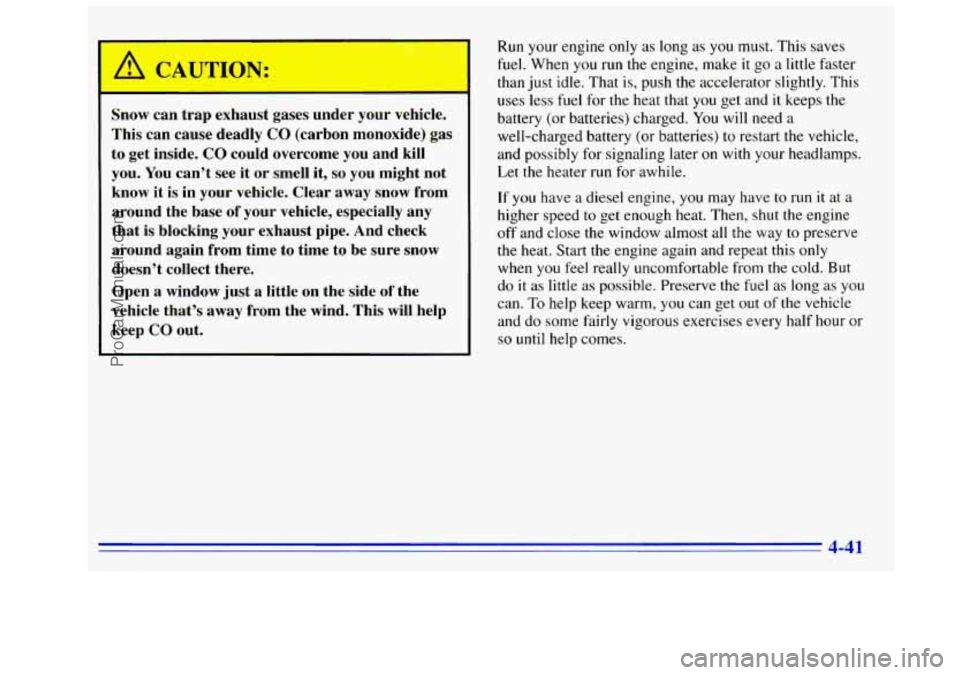
I /1 CAJTION:
Snow can trap exhaust gases under your vehicle.
This can cause deadly
CO (carbon monoxide) gas
to get inside. CO could overcome you and kill
you. You can’t see it or smell it,
so you might not
know it is
in your vehicle. Clear away snow from
around the base
of your vehicle, especially any
that is blocking your exhaust pipe. And check
around again from time to time to be sure snow doesn’t collect there.
Open a window just a little on the side of the
vehicle that’s away from the wind. This will help
keep
CO out.
Run your engine only as long as you must. This saves
fuel. When you run the engine, make it go a little faster
than just idle. That is, push the accelerator slightly. This
uses less fuel for the heat that you get and it keeps the
battery (or batteries) charged.
You will need a
well-charged battery (or batteries) to restart the vehicle,
and possibly for signaling later
on with your headlamps.
Let the heater run for awhile.
If
you have a diesel engine, you may have to run it at a
higher speed to get enough heat. Then, shut the engine
off and close the window almost all the way to preserve
the heat. Start the engine again and repeat this
only
when you feel really uncomfortable from the cold. But
do it as little
as possible. Preserve the fuel as long as you
can. To help keep warm, you can get out of the vehicle
and do some fairly vigorous exercises every half hour or
so until help comes.
4-41
~.
ProCarManuals.com
Page 196 of 404
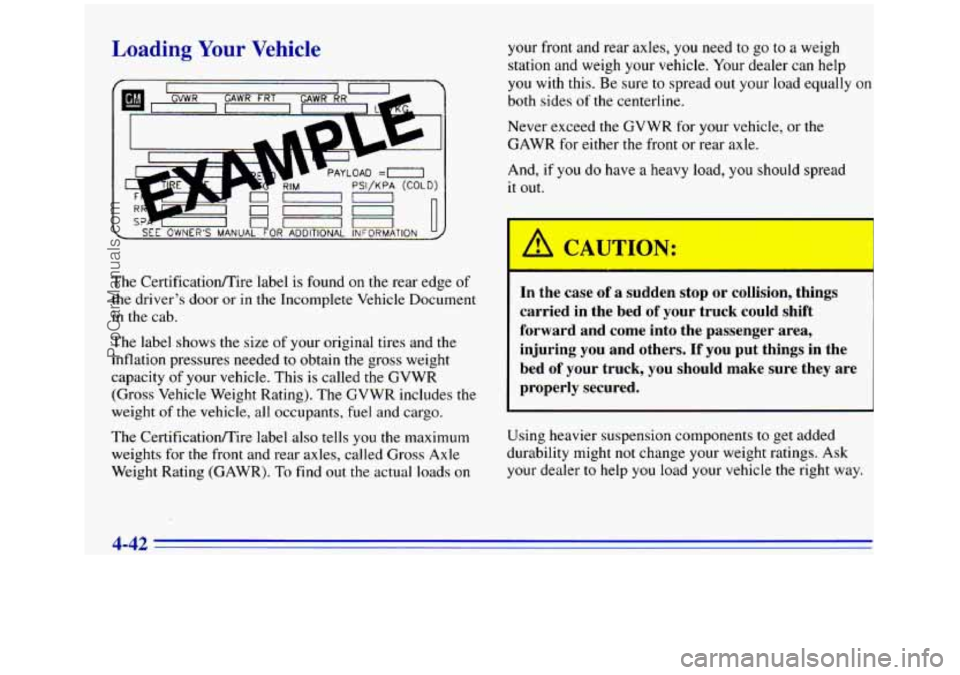
Loading Your Vehicle
n ", ,. , I --- SEE OWNER'S MANUAL FOR ADDITIONAL INFORMATION I U
The Certificatiomire label is found on the rear edge of
the driver's door or in the Incomplete Vehicle Document
in the cab.
The label shows the size of your original tires and the
inflation pressures needed to obtain the gross weight
capacity
of your vehicle. This is called the GVWR
(Gross Vehicle Weight Rating).
The GVWR includes the
weight of the vehicle, all occupants, fuel and cargo.
The Certificationmire label also tells
you the maximum
weights for the front and rear axles, called Gross
Axle
Weight Rating (GAWR). To find out the actual loads on your
front and rear axles,
you need to go to a weigh
station and weigh your vehicle. Your dealer can help
you with this. Be sure to spread out your load equally on
both sides of the centerline.
Never exceed the GVWR for your vehicle, or the
GAWR for either the front or rear axle.
And,
if you do have a heavy load, you should spread
it
out.
I
In the case of a sudden stop or collision, things
carried in the bed
of your truck could shift
forward and come into the passenger area,
injuring you and others.
If you put things in the
bed
of your truck, you should make sure they are
properly secured.
Using heavier suspension components to get added
durability might not change your weight ratings. Ask
your dealer to help you load your vehicle the right way.
4-42
ProCarManuals.com
Page 197 of 404
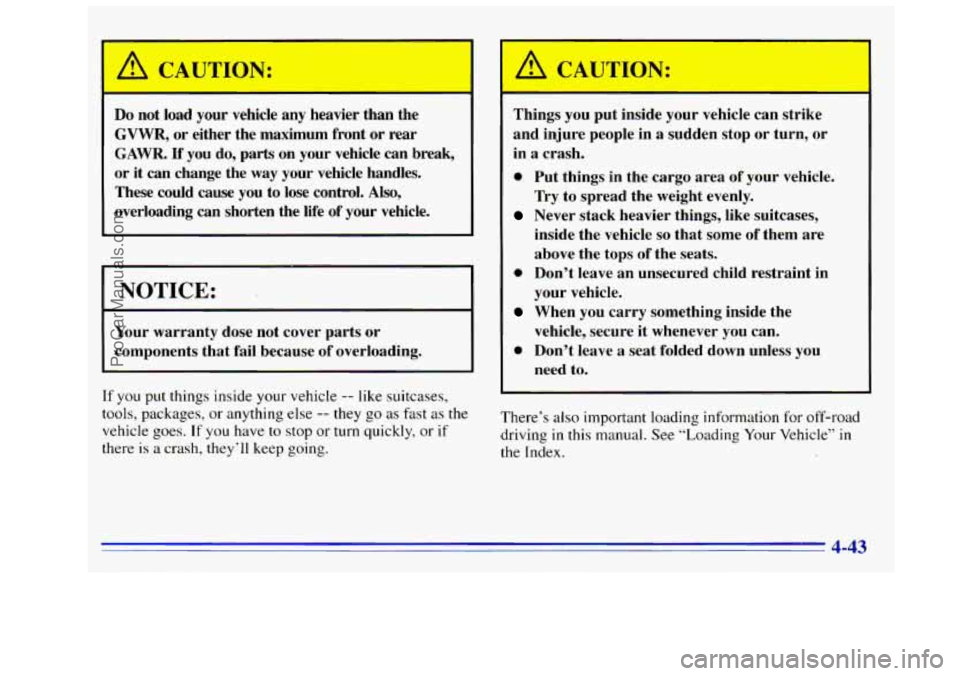
Do not load your vehicle any heavier than the
GVWR, or either the maximum front or rear
GAWR. If you do, parts on your vehicle can break,
or it can change the
way your vehicle handles.
These could cause you to lose control. Also,
overloading can shorten the life of your vehicle.
NOTICE:
Your warranty dose not cover parts or
components that fail because
of overloading.
If you put things inside your vehicle -- like suitcases,
tools, packages, or anything else
-- they go as fat as the
vehicle goes. If you have to stop or turn quickly, or if
there is a crash, they’ll keep going.
CriUTdN:
r
Things you put inside your vehicle can strike
and injure people in
a sudden stop or turn, or
in
a crash.
0 Put things in the cargo area of your vehicle.
Try to spread the weight evenly.
Never stack heavier things, like suitcases,
inside the vehicle
so that some of them are
above the tops
of the seats.
0 Don’t leave an unsecured child restraint in
your vehicle.
When you carry something inside the
vehicle, secure it whenever you can.
0 Don’t leave a seat folded down unless you
need to.
There’s also important loading information for off-road
driving
in this manual. See ”Loading Your Vehicle” in
the Index.
ProCarManuals.com
Page 198 of 404
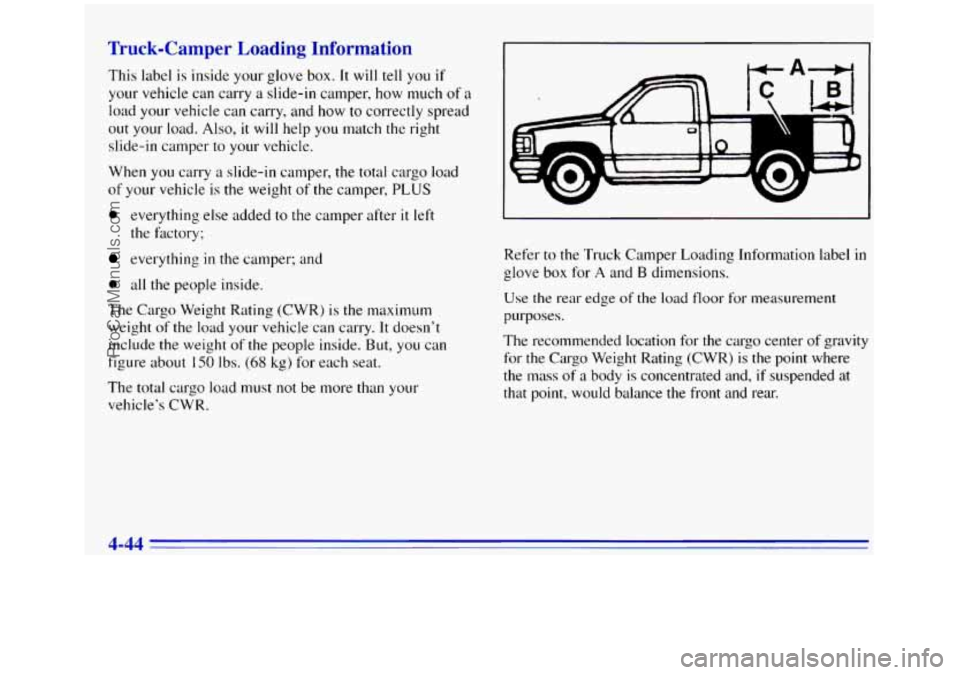
Truck-Camper Loading Information
This label is inside your glove box. It will tell you if
your vehicle can carry a slide-in camper, how much of a
load your vehicle can carry, and how to correctly spread
out your load.
Also, it will help you match the right
slide-in camper to your vehicle.
When you carry a slide-in camper,
the total cargo load
of your vehicle is
the weight of the camper, PLUS
0 everything else added to the camper after it left
the factory;
everything in the camper; and
0 all the people inside.
The Cargo Weight Rating (CWR) is
the maximum
weight
of the load your vehicle can carry. It doesn’t
include the weight
of the people inside. But, you can
figure about
1-50 Ibs. (68 kg) for each seat.
The total cargo load must
not be more than your
vehicle’s CWR. Refer
to the Truck Camper Loading Information label
in
glove box for A and B dimensions.
Use the
rear edge of the load floor for measurement
purposes.
The recommended location for the cargo center of gravity
for the Cargo Weight Rating (CWR)
is the point where
the mass of a body is concentrated and,
if suspended at
that point, would balance the front and rear.
4-44
ProCarManuals.com
Page 199 of 404
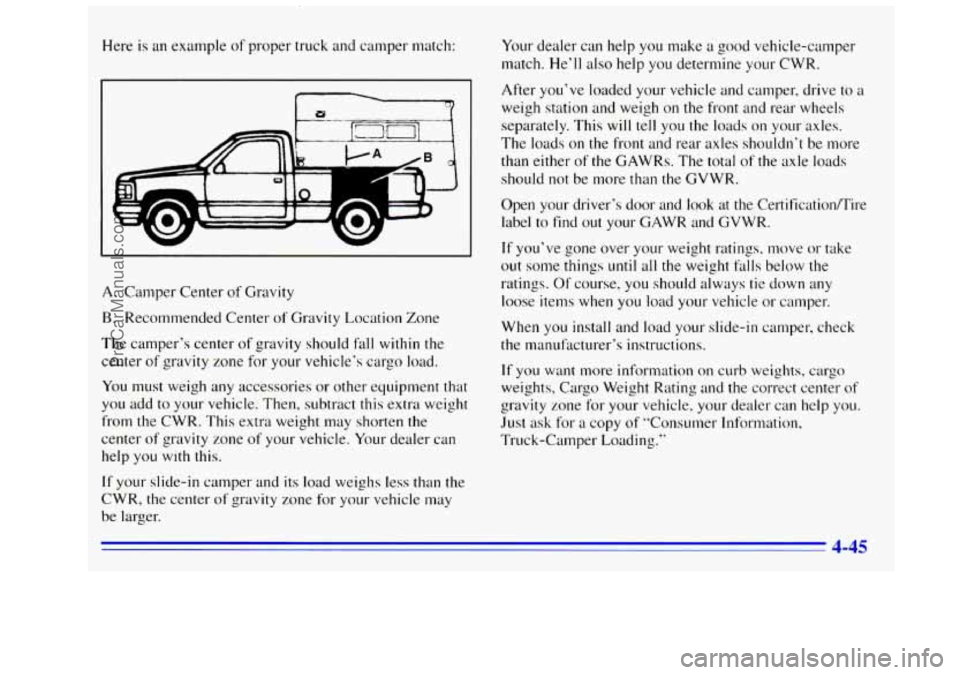
Here is an example of proper truck and camper match:
A. Camper Center of Gravity
B. Recommended Center of Gravity Location Zone
The camper‘s center of gravity should
fall within the
center of gravity zone
for your vehicle’s cargo load.
You must weigh
any accessories or other equipment that
you add
to your vehicle. Then, subtract this extra weight
from the CWR. This extra weight may shorten the
center
of gravity zone of your vehicle. Your dealer can
help
you with this.
If your slide-in camper and its load weighs less than the
CWR, the center of gravity zone for your vehicle may
be larger. Your
dealer can help
you make a good vehicle-camper
match. He’ll also help you determine
your CWR.
After you’ve loaded your vehicle and camper, drive to a
weigh station and weigh on the front and rear wheels
separately. This will tell
you the loads on your axles.
The loads
on the front and rear axles shouldn’t be more
than either of the GAWRs. The total of the axle loads
should not be more than the GVWR.
Open your driver’s door and
look at the Cel-tificationflire
label to find
out your GAWR and GVWR.
If you’ve gone over your weight ratings, move or take
out some things until all the weight f;llls below the
ratings. Of course,
you should always tie down any
loose items when
you load your vehicle or camper.
When
you install and load your slide-in camper, check
the manufacturer’s instructions.
If you want more information
on curb weights, cargo
weights, Cargo Weight Rating and the correct center
of
Just ask for a copy of “Consumer Information,
Truck-Camper Loading.”
L qravity zone for your vehicle, your dealer can help you.
’ 4-45
ProCarManuals.com
Page 200 of 404
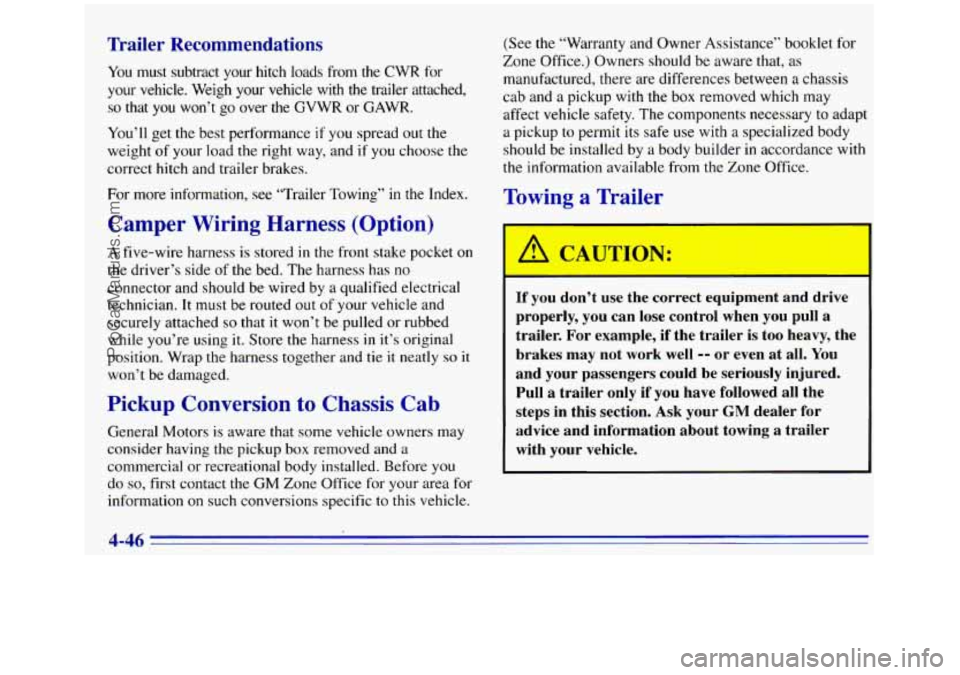
Trailer Recommendations
You must subtract your hitch loads from the CWR for
your vehicle. Weigh your vehicle with
the trailer attached,
so that you won’t go over the GVWR or GAM.
You’ll get the best performance if you spread out the
weight
of your load the right way, and if you choose the
correct hitch and trailer brakes.
For more information, see “Trailer Towing” in the Index.
Camper Wiring Harness (Option)
A five-wire harness is stored in the front stake pocket on
the driver’s side of the bed. The harness has
no
connector and should be wired by a qualified electrical
technician.
It must be routed out. of your vehicle and
securely attached
so that it won’t be pulled or rubbed
while you’re using it. Store the harness in it’s original
position. Wrap the harness together and tie
it neatly so it
won’t be damaged.
Pickup Conversion to Chassis Cab
General Motors is aware that some vehicle owners may
consider having the pickup box removed and
a
commercial or recreational body installed. Before you
do so, first contact the GM Zone Office for your area for
information on such conversions specific to this vehicle. (See the
“Warranty and Owner Assistance” booklet for
Zone Office.) Owners should be aware that, as
manufactured, there are differences between
a chassis
cab and a pickup with
the box removed which may
affect vehicle
safety. The components necessary to adapt
a pickup to permit its safe use with a specialized body
should be installed by a body builder in accordance with
the information available from the Zone Office.
Towing a Trail-r
If you don’t use the correct equipment and drive
properly, you can lose control when you pull a
trailer. For example, if the trailer
is too heavy, the
brakes may not
work well -- or even at all. You
and your passengers could be seriously injured.
Pull a trailer only if you have followed all the
steps in this section. Ask your
GM dealer for
advice and information about towing a trailer
with your vehicle.
I
4-46
ProCarManuals.com